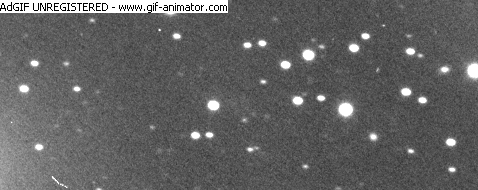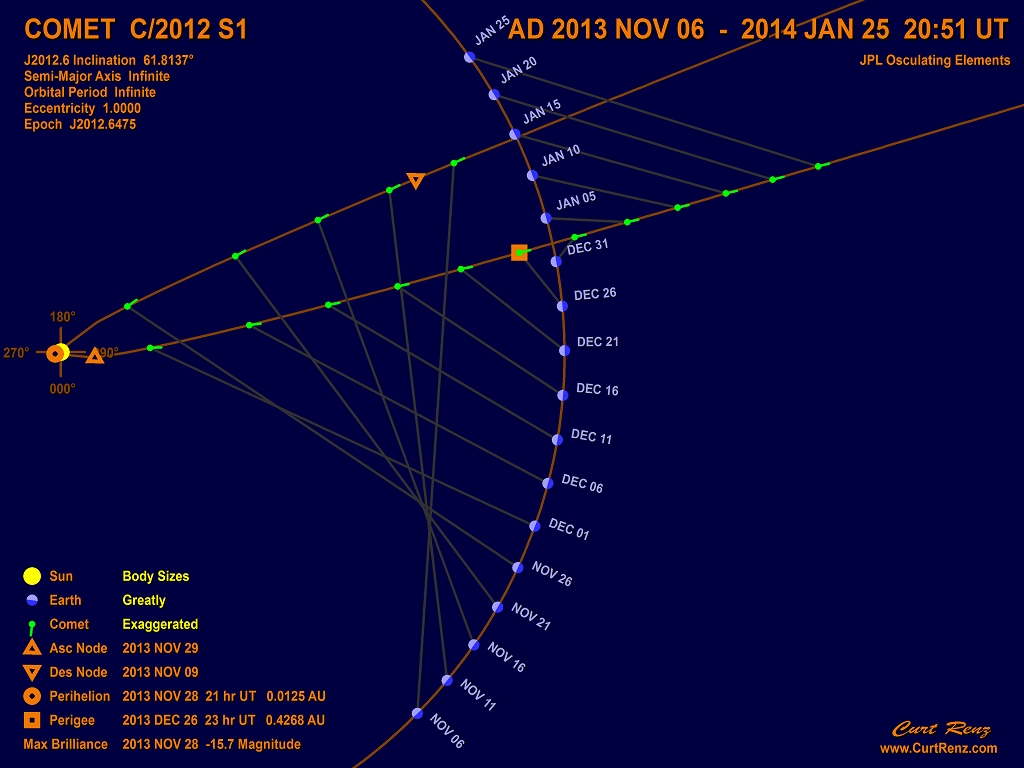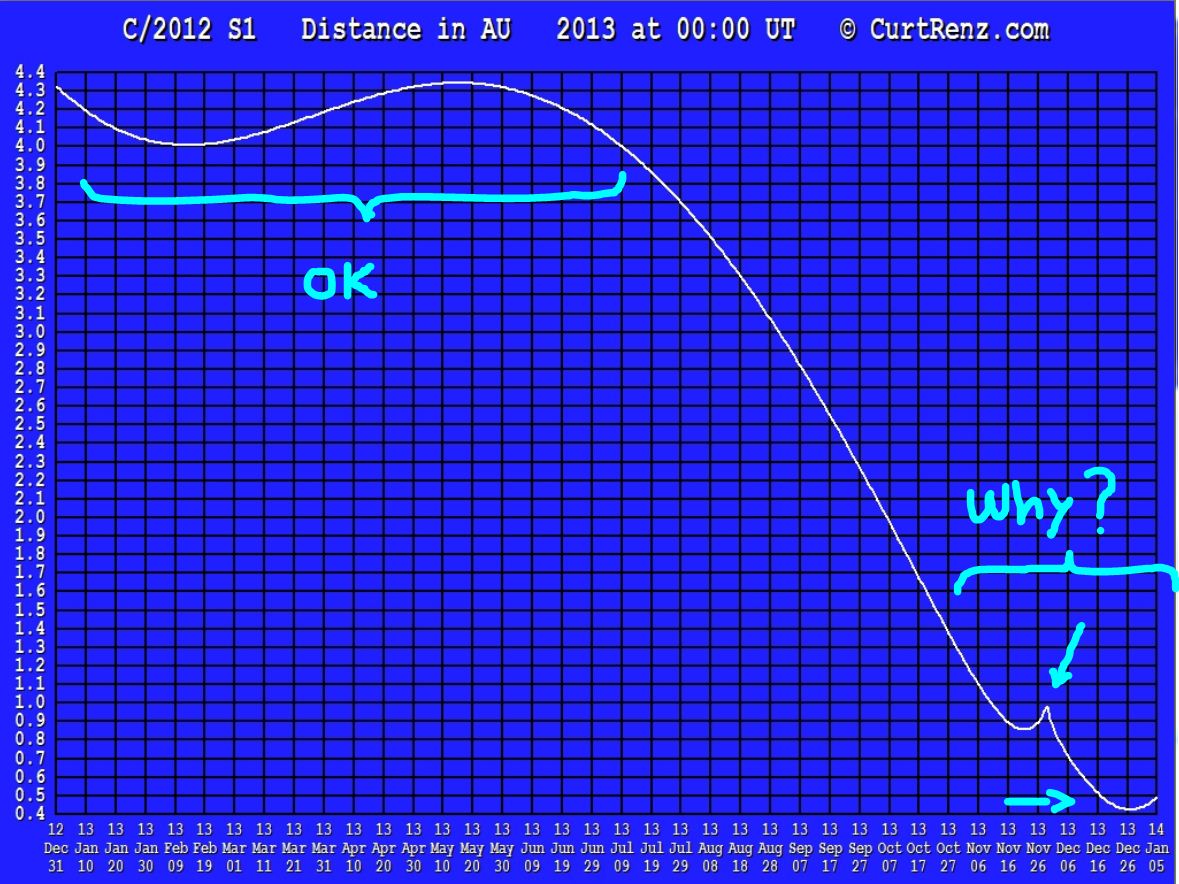It looks like you're using an Ad Blocker.
Please white-list or disable AboveTopSecret.com in your ad-blocking tool.
Thank you.
Some features of ATS will be disabled while you continue to use an ad-blocker.
share:
Mark your calendars people of ATS, a new comet has recently been discovered that may turn out to be the brightest comet since
Comet Hale–Bopp passed by in 1996, and perhaps even outshining it.
Source: click here
This is the image that confirmed the new comet.

Edit to add an animation:

Here is a ranking of some of the brightest comets in recent history:
Source: International Comet Quarterly
I've been waiting many years for a chance to photograph a comet like this. Hopefully it will live up to expectations as well as being visible from the Northern hemisphere when it's peaking in brightness.
Edit to add: One unusual and notable feature of this comet is that it belongs to a group of comets that are known as Sunskirters. Usually they are only spotted by the coronagraphs aboard the SOHO spacecraft, so well done to the team that found this one using a telescope
Edit to add alternative source (in Russian): www.utro.ru
Comet C/2012 S1 (ISON) will get to within 0.012AU of the Sun (extremely close) at the end of November 2013 and then to ~0.4AU from Earth at the beginning of January 2014! According to its orbit, this comet might become a naked-eye object in the period November 2013 - January 2014. And it might reach a negative magnitude at the end of November 2013.
Source: click here
This is the image that confirmed the new comet.

Edit to add an animation:

Here is a ranking of some of the brightest comets in recent history:
peak
m1 Comet
---- ----------------------
(-10) C/1965 S1 (Ikeya-Seki)
(-5.5) C/2006 P1 (McNaught)
-3.0 C/1975 V1 (West)
(-3) C/1947 X1 (Southern comet)
(-1) C/1948 V1 (Eclipse comet)
-0.8 C/1995 O1 (Hale-Bopp)
(-0.5) C/1956 R1 (Arend-Roland)
(-0.5) C/2002 V1 (NEAT)
0.0 C/1996 B2 (Hyakutake)
0.0 C/1969 Y1 (Bennett)
(0) C/1973 E1 (Kohoutek)
(0) C/1962 C1 (Seki-Lines)
0.5 C/1998 J1 (SOHO)
1.0 C/1957 P1 (Mrkos)
(1) C/1970 K1 (White-Ortiz-Bolelli)
1.7 C/1983 H1 (IRAS-Araki-Alcock)
(2) C/1941 B2 (de Kock-Paraskevopoulos)
(2.2) C/2002 T7 (LINEAR)
2.4 1P/1982 U1 (Halley)
(2.4) 17P (Holmes) [Oct. 2007]
2.5 C/2000 WM_1 (LINEAR)
2.7 C/1964 N1 (Ikeya)
2.8 C/2001 Q4 (NEAT)
2.8 C/1989 W1 (Aarseth-Brewington)
2.8 C/1963 A1 (Ikeya)
2.9 153P/2002 C1 (Ikeya-Zhang)
3.0 C/2001 A2 (LINEAR)
3.3 C/1936 K1 (Peltier)
(3.3) C/2004 F4 (Bradfield)
3.5 C/2004 Q2 (Machholz)
3.5 C/1942 X1 (Whipple-Fedtke-Tevzadze)
3.5 C/1940 R2 (Cunningham)
3.5 C/1939 H1 (Jurlof-Achmarof-Hassel)
3.5 C/1959 Y1 (Burnham)
3.5 C/1969 T1 (Tago-Sato-Kosaka)
3.5 C/1980 Y1 (Bradfield)
(3.5) C/1961 O1 (Wilson-Hubbard)
(3.5) C/1955 L1 (Mrkos)
3.6 C/1990 K1 (Levy)
3.7 C/1975 N1 (Kobayashi-Berger-Milon)
3.9 C/1974 C1 (Bradfield)
3.9 C/1937 N1 (Finsler)
Source: International Comet Quarterly
I've been waiting many years for a chance to photograph a comet like this. Hopefully it will live up to expectations as well as being visible from the Northern hemisphere when it's peaking in brightness.
Edit to add: One unusual and notable feature of this comet is that it belongs to a group of comets that are known as Sunskirters. Usually they are only spotted by the coronagraphs aboard the SOHO spacecraft, so well done to the team that found this one using a telescope
Edit to add alternative source (in Russian): www.utro.ru
edit on 24-9-2012 by FireballStorm because: fixed broken link hopefully
edit on 24-9-2012 by FireballStorm because: (no reason
given)
edit on 24-9-2012 by FireballStorm because: (no reason given)
It's the second coming of course. Note the name, I Son!
We're all gonna die...again.
We're all gonna die...again.
This is quite interesting, I don't think it's a new thing for comets to appear.. is it?
reply to post by Conceals
It unusual for them to put on a good display. This one is promising. It also appears to have a hyperbolic orbit which means it will only be making this visit to the inner solar system.
It unusual for them to put on a good display. This one is promising. It also appears to have a hyperbolic orbit which means it will only be making this visit to the inner solar system.
Oh cool, I cant wait to look up into the sky 2013 and see it. If I even remember it or if we live that long
As Phage says, this one is looking promising, keeping in mind that only a preliminary orbit has been calculated so far.
I came across this graph (more graphs and data here), which if I'm interpreting it correctly shows that Comet ISON should be high in the sky (presumably for northern hemisphere observers - but I see no mention of "hemispheres" in connection with that particular graph) when it starts to peak in brightness.
I'm hoping this also means it won't be close to the sun in terms of it's position in the sky, which would make it hard to observer/photograph.
Anyone care to confirm? Phage, ngchunter?
I came across this graph (more graphs and data here), which if I'm interpreting it correctly shows that Comet ISON should be high in the sky (presumably for northern hemisphere observers - but I see no mention of "hemispheres" in connection with that particular graph) when it starts to peak in brightness.
I'm hoping this also means it won't be close to the sun in terms of it's position in the sky, which would make it hard to observer/photograph.
Anyone care to confirm? Phage, ngchunter?
Originally posted by Phage
It's the second coming of course. Note the name, I Son!
We're all gonna die...again.
HaHa.... Really, how do they get named, Oh Phage Of Sky Stuff. (I figure this question is up your alley!)
reply to post by FireballStorm
Declination does not provide the elevation of an object, it is the "north-south" coordinate of the equatorial system. It will be visible in the northern hemisphere and, as with all comets, its brightness will be greater when it is closer to the Sun.
I think it should be visible (if it is) in the northern hemisphere before dawn from around mid December when it's on its way out.
Declination does not provide the elevation of an object, it is the "north-south" coordinate of the equatorial system. It will be visible in the northern hemisphere and, as with all comets, its brightness will be greater when it is closer to the Sun.
I think it should be visible (if it is) in the northern hemisphere before dawn from around mid December when it's on its way out.
reply to post by Phage
Thanks for clearing that up Phage.
I've always thought that the "ideal" comet would be at it's peak magnitude when at it's closest to Earth, at the same time as being far from the Sun in terms of it's position in the sky, and was hoping this was it, but even so this one still sounds very promising.
It should also be interesting to observe in conjunction with the approaching solar maximum.
Fingers crossed there will also be a meteor shower associated with Comet:ISON - I'm sure people are already calculating the possibilities and we will hear more about it in the coming days/weeks.
Thanks for clearing that up Phage.
I've always thought that the "ideal" comet would be at it's peak magnitude when at it's closest to Earth, at the same time as being far from the Sun in terms of it's position in the sky, and was hoping this was it, but even so this one still sounds very promising.
It should also be interesting to observe in conjunction with the approaching solar maximum.
Fingers crossed there will also be a meteor shower associated with Comet:ISON - I'm sure people are already calculating the possibilities and we will hear more about it in the coming days/weeks.
I don't see any evidence that the comet has a hyperbolic orbit. The elements in the JPL Small Bodies database show an eccentricity very slightly
greater than 1.0, but you have to remember that this orbit has been calculated based on the Sun as the centre of mass. The eccentricity will almost
certainly be slightly less than 1.0 with respect to the Solar System barycentre......unless the comet is gravitationally perturbed by one of
the giant planets.
Just another quick question, has anyone calculated yet the size of the comet ?
reply to post by AlphaHawk
Ok. So this variation of distance is related to earth rather than the sun.
So after the encounter with the sun it comes “back”, as shown in the next image, to the earth path.

source
The exposed thought leaves me with two questions:
First: why the amplitude (in time) of the first approximation to earth compared to the second, is three times smaller?
Second: Does the calculation of the comet’s orbit can be accurate, after the encounter with the sun? (The remark I make, it’s because of the uncertain result obtained with path of comet Lovejoy after is encounter with Sun)
Ok. So this variation of distance is related to earth rather than the sun.
So after the encounter with the sun it comes “back”, as shown in the next image, to the earth path.

source
The exposed thought leaves me with two questions:
First: why the amplitude (in time) of the first approximation to earth compared to the second, is three times smaller?
Second: Does the calculation of the comet’s orbit can be accurate, after the encounter with the sun? (The remark I make, it’s because of the uncertain result obtained with path of comet Lovejoy after is encounter with Sun)
edit on 25-9-2012 by voyger2 because: (no reason given)
Originally posted by Phage
It's the second coming of course. Note the name, I Son!
We're all gonna die...again.
I am not so sure this is really Phage any more,
Because the real Phage would have either known
or would have discovered that ISON is the ISON-NM Observatory,
Not some prophetic silly name. Nor would the real Phage have jumped to that kind of reasoning.
Where is the real Phage and what have you done with him
edit on 25-9-2012 by azureskys because: corrected things
Or at the least associated the Family Name of Ison from as far back as the Norman Conquest or before.
www.houseofnames.com...
Come on so called Phage, who are you really?
I have suspected you are an imposter ever since you changed your Avatar to a hang-glider.
edit on 25-9-2012 by azureskys because: added more
edit on 25-9-2012 by azureskys because: not
edit on
25-9-2012 by azureskys because: fixed
reply to post by voyger2
The comet will speed up as it approaches the sun, I think this is what you're asking?
And similarly, it's orbit will be better known as it get's closer to the sun. Lovejoy was projected to burn up as it passed by the sun, apart from that, as far as I'm aware, there weren't any anomalies in it's orbit.
The comet will speed up as it approaches the sun, I think this is what you're asking?
And similarly, it's orbit will be better known as it get's closer to the sun. Lovejoy was projected to burn up as it passed by the sun, apart from that, as far as I'm aware, there weren't any anomalies in it's orbit.
reply to post by AlphaHawk
ok. i think that answer the first question. But I’m not so sure if it answers the second. Has said, Lovejoy it was expected to burn... but that didn't happen... (had anyone predicted that? And is path after the sun, did it behave as it should have after that?) So maybe we can assume some uncertainty on his path after the sun?
thanks for the feedback
ok. i think that answer the first question. But I’m not so sure if it answers the second. Has said, Lovejoy it was expected to burn... but that didn't happen... (had anyone predicted that? And is path after the sun, did it behave as it should have after that?) So maybe we can assume some uncertainty on his path after the sun?
thanks for the feedback
Originally posted by azureskys
Originally posted by Phage
It's the second coming of course. Note the name, I Son!
We're all gonna die...again.
I am not so sure this is really Phage any more,
Because the real Phage would have either known
or would have discovered that ISON is the ISON-NM Observatory,
Not some prophetic silly name. Nor would the real Phage have jumped to that kind of reasoning.
Where is the real Phage and what have you done with himedit on 25-9-2012 by azureskys because: corrected things
Jesus is a comet silly... haha
It's the REAL phage all right, but with a more comedic flare. I wanna see more of that.
I cannot tell if you were being serious or not, but phage is apparently a little joker.
I can't wait for this. I have never seen a comet ever. I saw an amazing meteor shower though. I think I was about 8 so this is like 1995, or 1996, or 1994 somewhere in there. I was in South Carolina near georgia on a golf course. Laying on my back as thousands of fireballs flew through the sky... It was so intense, I thought the palm trees were going to catch fire. They looked SO close to the ground. I could see their tails all the way from one end to the other of the sky, and being on a golf course I could see a lot of sky...
I so want to re-experience something like this...
missed halebop however you spell that, but hoping, so hoping I don't miss this one.
by the way "A Stranger in a strange land" Is my all time favorite book. It's so amazing when you grock it all hahaha.
edit on 9/25/2012 by
Dustytoad because: (no reason given)
I can see the videos now...
- The Mayan Calendar was misinterpreted and this is the object they were talking about, Get ready folks, this shizz just got real..
along with
- This has all the traits of Nibiru, check out the orbit, where it is approaching from, and the size of this thing, it can't be a comet. NASA are liars, the government (Head explodes)
Then
The world ends of course once again and we find another cosmic object to beat off too...
- The Mayan Calendar was misinterpreted and this is the object they were talking about, Get ready folks, this shizz just got real..
along with
- This has all the traits of Nibiru, check out the orbit, where it is approaching from, and the size of this thing, it can't be a comet. NASA are liars, the government (Head explodes)
Then
The world ends of course once again and we find another cosmic object to beat off too...
The accuracy of a comet's determined orbit is based on the number of observations used, the accuracy of those observations, and the length of
the "arc" in which those calculated positions have been obtained. As the comet is observed over time, the length of the arc (section of orbit) used
for calculating positions (and the number of observations themselves) will increase, which will result in improved accuracy of the determined orbital
elements. A comet that approaches the Sun as closely as this one will also suffer from "relativistic effects", but these can easily be calculated by
modern computers.
Of course, there is always great uncertainty with respect to non-gravitational forces (the rocket like thrusting effect associated with sublimating ices of varying composition) when dealing with "new" comets, but even these will be refined as the orbit determination becomes more accurate.
Of course, there is always great uncertainty with respect to non-gravitational forces (the rocket like thrusting effect associated with sublimating ices of varying composition) when dealing with "new" comets, but even these will be refined as the orbit determination becomes more accurate.
edit on 25-9-2012 by Mogget because: (no reason given)
new topics
-
It's Offical Now
US Political Madness: 1 hours ago -
The reason it works is.....
General Chit Chat: 1 hours ago -
Dick Van Dyke saved from Wildfire by neighbours on his 99th birthday
People: 4 hours ago
top topics
-
Dick Van Dyke saved from Wildfire by neighbours on his 99th birthday
People: 4 hours ago, 3 flags -
The reason it works is.....
General Chit Chat: 1 hours ago, 2 flags -
It's Offical Now
US Political Madness: 1 hours ago, 2 flags
active topics
-
The reason it works is.....
General Chit Chat • 1 • : Naftalin -
It's Offical Now
US Political Madness • 4 • : theatreboy -
1 Billion dollars
General Entertainment • 12 • : Blueracer -
London Christmas Market BANS Word ‘Christmas’
Social Issues and Civil Unrest • 41 • : Oldcarpy2 -
Trump says ownership of Greenland 'is an absolute necessity'
Other Current Events • 49 • : Xtrozero -
Can someone 'splain me like I'm 5. Blockchain?
Science & Technology • 97 • : Xtrozero -
NYPD arrests migrant who allegedly set woman on fire on subway train, watched her burn to death
Breaking Alternative News • 53 • : GENERAL EYES -
-@TH3WH17ERABB17- -Q- ---TIME TO SHOW THE WORLD--- -Part- --44--
Dissecting Disinformation • 3809 • : Crazierfox -
Christmas Dinner ??
Food and Cooking • 16 • : Naftalin -
Dick Van Dyke saved from Wildfire by neighbours on his 99th birthday
People • 0 • : gortex

